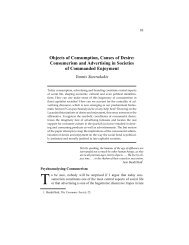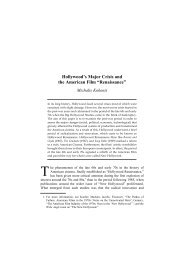19 International Symposium on Theoretical and Applied Linguistics ...
19 International Symposium on Theoretical and Applied Linguistics ...
19 International Symposium on Theoretical and Applied Linguistics ...
You also want an ePaper? Increase the reach of your titles
YUMPU automatically turns print PDFs into web optimized ePapers that Google loves.
G E N E R A L S E S S I O N<br />
Note that the problem is bigger in morphologically-rich languages, such as Greek, because of the<br />
presence of affix chains before or after a stem, <strong>and</strong> the structural combinatorial properties of<br />
derivati<strong>on</strong>al suffixes.<br />
(1) koin<strong>on</strong>ikotita koin – <strong>on</strong> – ik – otita – Ø<br />
‘sociality’ stem – suf – suf – suf – INFL<br />
antiekpaideftikos anti – ek – paid – ef – t – ik – os<br />
‘anti-educati<strong>on</strong>al’ pref – pref – stem – suf – suf – suf – INFL<br />
The aim of this work is to deal with the extended allomorphic behaviour of the Greek language <strong>on</strong><br />
any level of word formati<strong>on</strong>. After an attempt of the Two-Level Morphology Model to deal with<br />
allomorphy (Krieger, Pirker <strong>and</strong> Nerb<strong>on</strong>ne <str<strong>on</strong>g>19</str<strong>on</strong>g>93), the supporters of UML avoid treating allomorphic<br />
stems, or they import allomorphs as different morphemes. However, Greek allomorphy is very<br />
important for Greek morphology, <strong>and</strong> a very comm<strong>on</strong> phenomen<strong>on</strong>. For instance, nominal stems with<br />
allomorphy bel<strong>on</strong>g to 5 out of the 8 inflecti<strong>on</strong> classes (according to Ralli 2000, 2005, 2006),<br />
allomorphy characterizes prefixes [32%] <strong>and</strong> suffixes [87%], <strong>and</strong> determines the inflecti<strong>on</strong> of verbs:<br />
(2) soma ~somat soma somat-a<br />
(noun) ‘body’ bodies<br />
pern ~pir ~par pern-o pir-a (tha) par-o<br />
(verb) ‘I take’ ‘I took’ ‘I will take’<br />
yp(o) ~yf ypo-stratigos yf-ypourgos<br />
(prefix) major-general vice-minister<br />
dzi ~dzidh taxi-dzi-s taxi-dzid-es<br />
(suffix) taxi driver taxi drivers<br />
In this study, I will show why a UML model cannot deal successfully with the case of Greek<br />
allomorphy, <strong>and</strong> how it leads to the wr<strong>on</strong>g segmentati<strong>on</strong> of morphemes. As a soluti<strong>on</strong>, I will propose a<br />
set of allomorphic transformati<strong>on</strong>s, <strong>and</strong> some comm<strong>on</strong> regularities of allomorphy, which can be<br />
expressed by rules, <strong>and</strong> can assist a morphological parser in order to deal adequately with Greek<br />
words.<br />
References<br />
Goldsmith, J. 2001. Unsupervised Learning of the Morphology of a Natural Language. Computati<strong>on</strong>al <strong>Linguistics</strong><br />
27, vol 2, pp. 153-<str<strong>on</strong>g>19</str<strong>on</strong>g>6.<br />
Hafer, Margaret A. & Stephen F. Weiss. <str<strong>on</strong>g>19</str<strong>on</strong>g>74. Word segmentati<strong>on</strong> by letter successor varieties. Informati<strong>on</strong><br />
Storage <strong>and</strong> Retrieval, 10:371-385.<br />
Harris, Z. <str<strong>on</strong>g>19</str<strong>on</strong>g>55. From ph<strong>on</strong>eme to morpheme. Language, 31:<str<strong>on</strong>g>19</str<strong>on</strong>g>0-222. Reprinted in Harris <str<strong>on</strong>g>19</str<strong>on</strong>g>70.<br />
Harris, Z. <str<strong>on</strong>g>19</str<strong>on</strong>g>67. Morpheme boundaries within words: Report <strong>on</strong> a computer test. Transformati<strong>on</strong>s <strong>and</strong> Discourse<br />
Analysis Papers 73, Department of <strong>Linguistics</strong>, University of Pennsylvania. Reprinted in Harris <str<strong>on</strong>g>19</str<strong>on</strong>g>70.<br />
Krieger H.U, Pirker H. & Nerb<strong>on</strong>ne J. <str<strong>on</strong>g>19</str<strong>on</strong>g>93. Feature-based allomorphy. Annual Meeting of the ACL, In:<br />
Proceedings of the 31st annual meeting <strong>on</strong> Associati<strong>on</strong> for Computati<strong>on</strong>al <strong>Linguistics</strong>, pp. 140 - 147.<br />
Ralli, A. 2000. A feature-based analysis of Greek nominal inflecti<strong>on</strong>. Glossologia 11-12, pp 201-228.<br />
Ralli, A. 2005. Morpholojia. Patakis Publ.<br />
Ralli, A. 2006. On the role of Allomorphy in inflecti<strong>on</strong>al Morphology: Evidence from Dialectal variati<strong>on</strong>. Advances<br />
of Language Studies 1, pp 1-32.<br />
L2 acquisiti<strong>on</strong> of English Present Perfect interpretati<strong>on</strong>s<br />
Sviatlana Karpava<br />
University of Cyprus<br />
Svetik_bgu@hotmail.com<br />
The present study investigates the role of L1 in the L2 acquisiti<strong>on</strong> of Present Perfect in terms of form<br />
<strong>and</strong> meaning interpretati<strong>on</strong> possibilities. The primary goal is to determine whether transfer from<br />
mother-t<strong>on</strong>gue, in which the Perfect has <strong>on</strong>ly a resultative reading <strong>and</strong> the Simple Past has both<br />
resultative <strong>and</strong> existential interpretati<strong>on</strong>s, influences the acquisiti<strong>on</strong> of the English Present Perfect by<br />
Greek-Cypriot pupils. Diagnostic tests suggested by Agouraki (2006) are employed in this study,<br />
based <strong>on</strong> the (in)compatibility of certain types of adverbials with existential, result perfect <strong>and</strong> simple<br />
past.<br />
There are certain differences between the form, interpretati<strong>on</strong> <strong>and</strong> frequency of the Present Perfect<br />
in English, St<strong>and</strong>ard Modern Greek (SMG) <strong>and</strong> Cypriot Greek (CG). St<strong>and</strong>ard Modern Greek (SMG)<br />
has two forms, Present Perfect A (formed with auxiliary eho ‘have’ <strong>and</strong> perfective participle) <strong>and</strong><br />
Present Perfect B (eho ‘have’+ adjectival participle for transitive verbs <strong>and</strong> ime ‘be’+ adjectival<br />
participle for intransitive verbs). In SMG Present Perfect A is ambiguous between an existential<br />
reading <strong>and</strong> a resultative reading; Present Perfect B can <strong>on</strong>ly have the result reading, whereas past<br />
<str<strong>on</strong>g>19</str<strong>on</strong>g> th ISTAL 25






